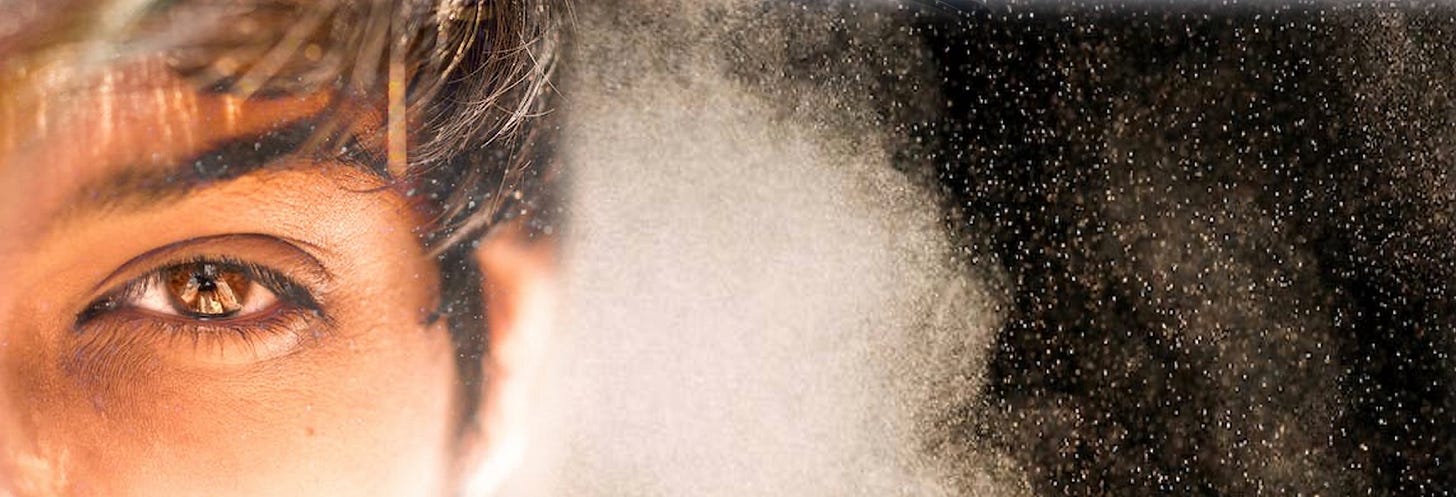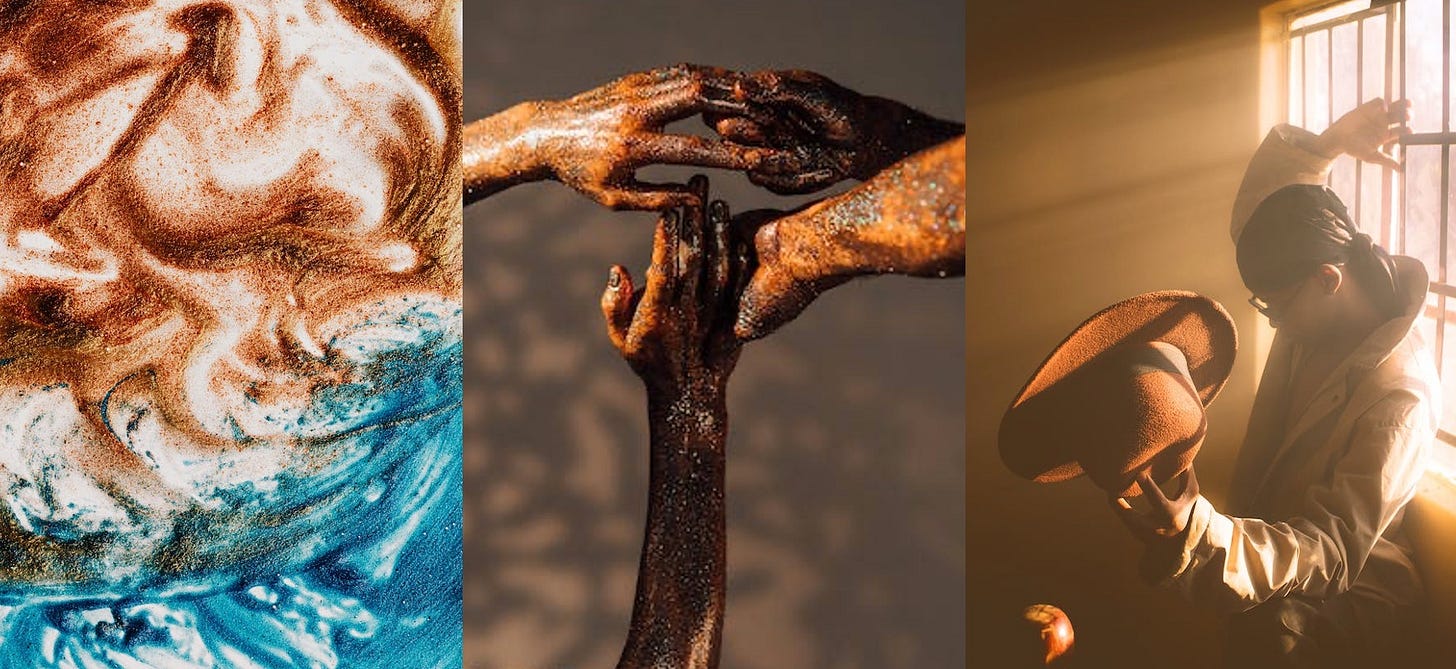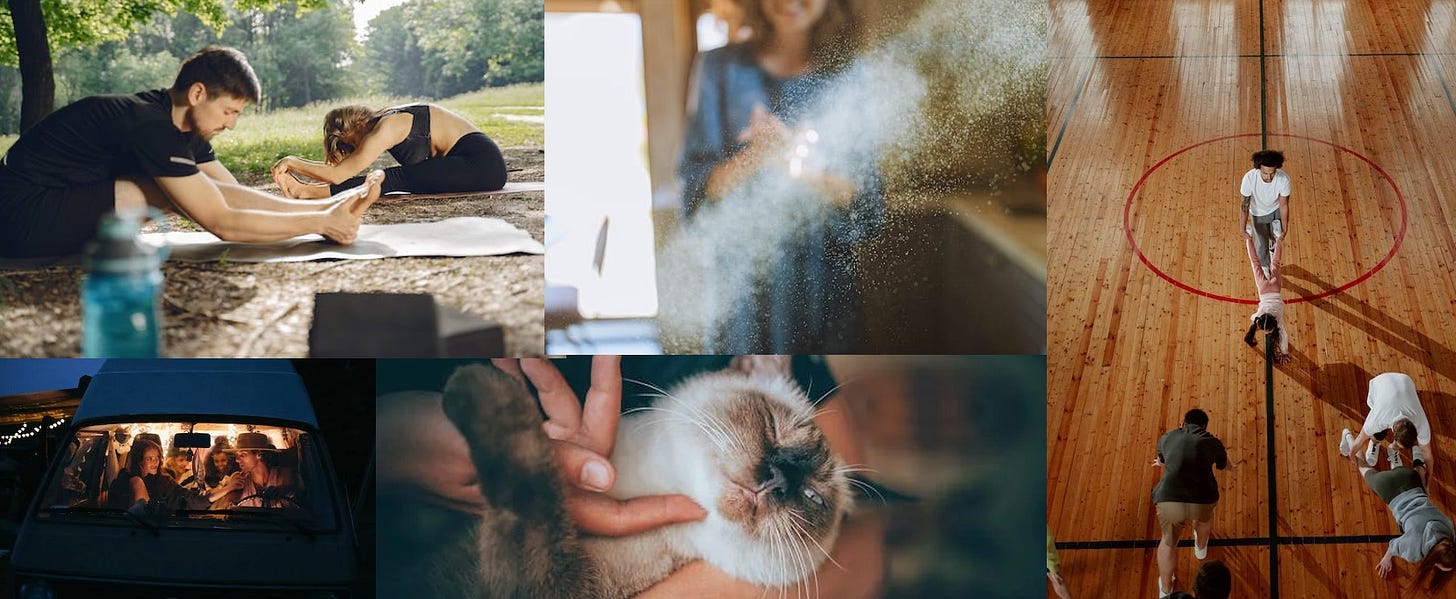🍄 Walk on the Rewilder Side
Global microbial products market size is expected to hit around $302 billion by 2030, making the five million trillion trillion (or 5 x 10 to the 30th power) bacteria our fellow travelers.
Exploring every rabbit hole there is. For more wanderings, become an Alice in Futureland subscriber—it's free.
🍄 AudioDose: this is Alice on Sonic Mushrooms. Rewild here.
🎧 Alice in Futureland Podcasts
Birds do it, bees do it, even Leonardo DiCaprio does it, rewilding – let’s crawl in mud.
(Photo by Shirsendu Adak, pexels)
Hello, we’re Alice and we are always in a state of wander. There’s something in the air. A cloud we carry with us actually, consisting of hundreds of thousands of billions of microbes, ten times the number of our human cells.
Stanford University researchers have dubbed the mixing of our microbial clouds, a “Pig-Pen,” after the beloved Peanuts character. Often extremely mucky, Pig-Pen is a boy who attracts a permanent cloud of dirt, but he’s proud to be cloaked in the ‘dust of countless ages.’
Dirt Happens
Imagine your own cloud of microbes swirling around you, interacting with everyone and everything in your surroundings. It’s your permanent plus one (hundred, thousand, billion...). Studying the human ‘exposome,’ the Stanford scientists describe each cloud as one part environmental shared with immediate neighbors; and one part more personal, consisting of human and pet-centric bacteria, fungi, parasites, and protozoa.
Each exposome consists of every person’s collective exposures from their time in the womb throughout the rest of their life. Every cloud is a busy bag of viruses, bacteria, fungi and things that we take everywhere. And that cloud is considerable, with all our microbes together weighing a kilo and a half.
What Is Rewilding?
The term ‘rewilding’ was first used in print in 1992 and has since been tagged over 372K times on Instagram (April 2023). Rewilding happens when humans stop interfering in natural processes. It’s the idea of relinquishing control to nature and, of reversing the damage already done.
It’s the protection of woodlands to encourage wildlife. It’s reducing grazing animals to help trees grow and increase carbon storage. In DiCaprio’s case, it’s bringing wild bison back into Britain.
According to the U.N., roughly one million animal and plant species are now threatened with extinction, many within decades, more than ever before in human history. Seventy-five percent of the terrestrial environment has been “severely altered” to date by human actions.
As animal and plant diversity is decreasing, the pace of global microbial change is unknown. As research continues however, we’ll learn of ways to manipulate microbial communities to rewild our urban environment with green technologies, as well as a host of other things we need help with from combating climate change to up-cycling waste and fermenting new foods.
Biodiversity is all the different kinds of life you'll find in one area—the variety of animals, plants, fungi, and even microorganisms like bacteria that make up our natural world—and our bodies.
Too little to lay eyes on, it’s estimated that there could be more than 1 billion different species of microbe on Earth. Each organism falls into one of five major types: Viruses, Bacteria, Archaea, Fungi, and Protists. Every one of these species then work together in ecosystems, like an intricate web, to maintain balance and support life.
Biodiversity is vital for the ecosystem and so too is microbial diversity.
We All Have Our Head In The Microbial Clouds
Our microbial fingerprint is not ours alone—it’s born from the interconnectivity between our microbiome and the world. Our personal microbial gardens need to be pruned and replanted to keep its community healthy. How do we do that? By venturing out in the “wild”—everyday life where we introduce our microbiome to what’s out there (besides us). Our microbiomes need to mingle, cross-pollinate, and get caught in the clouds of other microbiomes living on everything that surrounds us.
And never more urgently than now. Why? Because ‘promoting connections to the microbes many of us currently shun should be a key part of any post-pandemic recovery strategy,’ writes Jake M. Robinson, PhD, researcher, Department of Landscape, University of Sheffield, in The Conversation. ‘We must protect and promote the invisible biodiversity that is vital to our personal and planetary health.’
Our Data is Roaming
Your invisible cloud follows you everywhere you go and sheds snippets of your life. Think of the data clouds that track and contain your digital fingerprints of information. Well, the distinct combination of microbes in your microbial cloud can also be used to reveal gender, age, link people to geographic locations, and much more.
Your cloud contains millions of your own bacteria that never leave your side. They’re a by-product of your microbiome, which researchers have found emits as many as one million biological particles that escape our body and can leave microbial fingerprint on our surroundings (what microbiologists call the built environment). Think of making direct contact with surfaces, or that tiny piece of skin you shed as it gets moved about, a dust of microbes escape. The bio-composition of our odors, from breath, skin, and hair, also leaves traces. We can essentially track microbial communities in the built environment back to an individual person, based on their direct contact with an object from a school desk to a cellphone.
This Time, It’s Personal
Our unique microbial clouds are especially interesting to researchers studying epigenetics. We know now that the effects of environmental exposures—lifestyle, diet, stress, the effects of drugs, or instances of other diseases—can trigger a particular gene to turn on or off. It seems that the microbes that exist in our clouds and our surroundings are now being considered part of that pool of environmental epigenetic stressors. An especially large body of emerging research is looking at the epigenome and microbiome as part of a larger portrait: the exposome.
The exposome can be defined as the measure of all the exposures of an individual in a lifetime and how those exposures relate to health. The term “exposome” originated from a cancer researcher named Christopher Wild, a result of his concerns for unexplained diseases that led to cancer. This was in 2005, when the science community was sequencing the human genome, and its hope for the holy grail of disease origins had overshadowed the importance of environmental exposures on our health.
The Others
Your exposome lives in a world of “others.” Other people, other animals, other environments. The challenge of understanding the impact of living in diverse microbial clouds is how we can detect and monitor all these different clouds we breathe in every moment. One possible solution came from a team of researchers in 2018 at the Department of Genetics of Stanford University School of Medicine.
They built a wearable device, which continually sampled the air that their fifteen participants were exposed to when they were at home, at work, or on the road, collecting the various biological and chemical compounds.After three months, the team analyzed the filters using DNA sequencing and found that the fifteen participants had been exposed to 2,560 biological species.
Talk About An Evolution!
Humans and our microbial dwellers have a collective genome and a life history together. So much so that microbiologists call the microbes found in soil-y places like grass or the woods, our “old friend” microbes. They hypothesize that these microbes evolved alongside humans, settling in with each migration through the centuries. These soil microbes populated us as we populated the planet; we are truly a master host of symbiotic microbiota.
“Old friend” microbes play a major role in educating our immune system to help fight infectious diseases like COVID-19. Our immune defense is impossible without support from diverse microbiomes, and just as microbes have important roles in ecosystems—helping plants grow, recycling soil nutrients, etc.—they also provide our bodies with nutrients and health-sustaining chemicals that boost our immune system and promote good physical and mental health.
Missing Microbes
It should be clear by now that even short-term antibiotic treatments can lead to long-term shifts in the microbes colonizing our bodies. A full recovery or bounce-back of healthy bacteria is in no way guaranteed, despite the long-held belief that such was the case. But that is not my only worry. I also fear that some of our residential organisms— what I think of as contingency species—may disappear altogether.
—Martin J. Blaser, Missing Microbes: How the Overuse of Antibiotics Is Fueling Our Modern Plagues
Hello My Old Friend…
Humans are creating a severe biodiversity loss and industrial urbanization is a major factor, disrupting the symbiosis between microbiota and their hosts (such as humans, animals and plants). Our industrialized urban habitats are low in microbial biodiversity, upsetting the habitats in which microbes colonize. Microbes cannot fend for their colony or send signals to defend invasions and the whole ecosystem becomes weak – including the one we carry with us.
Microbiology researchers are working to identify ways to apply microbiome rewilding into daily urban life. Stay tuned.
Leading Indicators:
🧠 The Guest House
Earth’s fastest growing biome is the indoor environment – unsurprising if you consider that Americans spend as much as 90 percent of their time inside (!) Our microscopic roommates include a community of microorganisms (bacteria, fungi, and viruses) that live alongside us. There is evidence of interaction between the chemical components of our house dust and the biological community of the home biome. New tools using A.I. and crowd-sourced data, such as the Map My Environment global initiative can help create a complete understanding of a person’s health as well as that of their home community.
(Credit: Matthijs de Block)
🧠 Give Them A Good Home
Matthijs de Block is a research-based artist from Belgium linking science with societal shifts. He found research showing that people who live in and around natural environments such as woodlands enjoy a more diverse and better microbial cloud than city-dwellers and are therefore better protected against illnesses, allergies and depression. In 2019, de Block distilled as many different types of microbes possible from the earth, air and trees in high quality and biodiverse woods in Flanders, and combined them into a microbe cocktail. He built ‘Microbial Terrazzo,’ a new raw material in which the microbes were integrated alive. From this he made an installation, encouraging visitors to interact and adopt new, advantageous microbe species. The longer the interaction, the higher chance of leaving with new health.
Books we love
📘 In his book Missing Microbes, Dr. Martin Blaser takes us into the wilds of the human microbiome where for hundreds of thousands of years bacterial and human cells co-existed. But now, parts of our microbiome are missing and this invisible eden is being irrevocably damaged by some of our most revered medical advances—antibiotics—threatening the extinction of our microbes with terrible health consequences. (Macmillian, February 2014)
📘 Combining cutting-edge neuroscience with the latest discoveries on the human microbiome, The Mind-Gut Connection by Emeran Mayera, MD conclusively demonstrates the inextricable, biological link between mind and body. (HarperWave June 2018)
📘 From panspermia (the bacteria dust from our galaxy) and the microbiomes of our homes and our environments, to emerging research on microbes’ role in our social emotions of love and empathy, and the realization that we are a superorganism, made up of trillions of bacteria that may be what makes us “human,” ALICE’s Thriving with Microbes is a guide to the vibrant microbial world we inhabit.
What else we are wandering
🔍 You’re Not On The List
Plants are calling security. A study from Michigan State University in East Lansing shows that a plant’s genes act like gatekeepers for the possible millions of microbes bombarding them in our homes and neighborhoods. The scientists found that plant genes select which microbes they allow to live inside their leaves in order to stay healthy. It appears that organisms, from plants to animals, may share a similar strategy to control their microbiomes.
🔍 Mass-Transit Microbes
Trillions of microbes are hitching a ride. We know how underground microbes keep our soils rich but studies are now directing their attention to the deep pulse of so many cities, the urban subway. To picture how major these microbial breeding grounds are a study in 2018 of the microbial community of the Hong Kong subway system revealed that while each line had its own common species, it was mixed and dispersed throughout the day by its commuters. The most common bacteria found? Skin bacteria.
🔍 And in New York…
Scientists from Weill Cornell Medical College in New York mapped microbes at subway stations as well as on the trains, creating NYC’s other subway map, the “Pathomap.”
🔍 Flying Muck
There’s a microbiome high in the sky. Researchers have found that not all floating microbes linger in one area. A multitude of bacteria and viruses are blown upward into the part of the atmosphere; microbial particles that break loose from soil dust and sea spray. They travel skyward where they can linger for days before being dropped back down to Earth—an estimate of more than 800 million viruses are deposited per square meter into the atmosphere every day—that’s about twenty-five viruses for each person in Canada. In the samples collected, between 60 percent and 100 percent of the bacteria were alive, and they typically lived in the sky for five days or more. How’s that for a cloud.
Craving more?
📘 Alice in Futureland books
🎧 Alice in Futureland Podcasts
Thanks for tuning in.
For more wanderings, become an Alice in Futureland subscriber—it's free.
Invite your friends to this mad tea party and let's see how many things we can learn before breakfast.
©2023 Alice in Futureland











